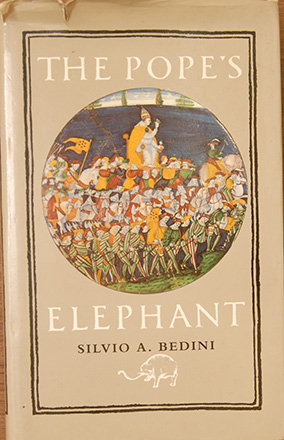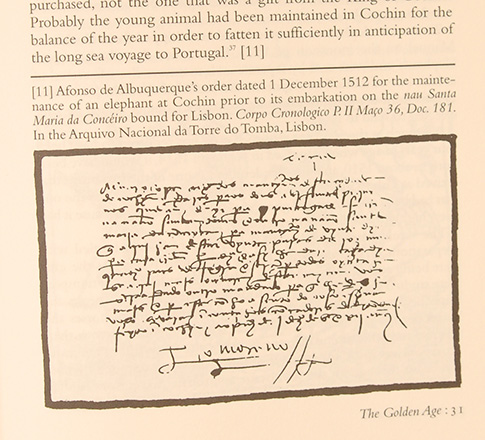Anyone who knows the Cochin Royal Family will know about their love for elephants. That fascination for elephants continue to this day. So, when I read Bedini's book about an elephant shipped to Portugal as a gift from the Raja of Cochin - Raja Unni Rama Koil - in 1512, I felt this story needs to be told to the family and hence its inclusion on this web site. The book is about Europe and the Vatican and the prevailing attitudes during the Renaissance towards 'the orient.'
The Pope’s Elephant
By Sivio A. Bedini
A book review by Usha Varma.
The author is a Historian Emeritus at the Smithsonian Institute in Washington D.C. He served as Deputy Director of the National Museum of History and Technology ( Now the National Museum of American History) and also as Smithsonian’s Keeper of the rare books.
He was engaged in research in the Vatican museum and archives. It was on one such visit to the Vatican, that he heard that once upon a time an elephant lived at the Vatican . Casual remarks, strange coincidences and a lot of hardcore scholarly research yielded the true remarkable story of an elephant named Hanna who travelled the seas from Cochin to Portugal in 1513. King Manuel of Lisbon gifted her to Pope Leo the tenth who fell in love with her.
The book gives fascinating details of the election of Cardinal Giovani De’ Medici, son of Lorenzo the Magnificent of Florence , 'an asthete, an epicure, and a scholar', in effect the ruler of Tuscany, as Pope, Leo the Tenth. Under his papacy Rome shined with talented artists and poets, painters like Raphael and sculpters like Michaelangilo. It was the era of Renaissance.
In Portugal, King Manuel was basking in the glory of the successful explorations to the East. The Islamic monopoly of spice trade and religious conversions were dented. The riches flowed in. The Pope had communicated in a letter (Apostolic brief of January 18
th) to King Manuel acknowledging that ' the Portuguese motive for conquest was not ambition , nor the acquisition of territory and extension of his lands, but the sincere desire to propagate the Law and the knowledge of the faith in those regions.' King Manuel made elaborate plans to send a delegation with incredible, magnificent Gifts to Rome 'on a mission of obedience', as was the tradition.
 1513 A.D. an elephant in the Vatican.
1513 A.D. an elephant in the Vatican.
 A page from Bedini's book
A page from Bedini's book
Bedini brings to life, in great detail, this story of Europe. The chief delegates accompanying the elephant ( with his caprisons and paraphernalia packed in trunks) and all the other precious gifts, were Tristao da Cunha, the famous navigator; and renowned Juris consult Diogo Pacheco. After the grand procession reached the designated venue in Vatican, Pacheco delivered 'the oration of obedience' in the bombastic style of the times, in Latin.
Writes Bedini: “ Eloquar an sileam?" he began, “ Shall I speak or be silent? With the greatest eloquence he placed India at the feet of the Pontiff, whom he said he viewed .. as he sat with his cardinals around him .. as a sun surrounded by stars. They were the representatives of the church for which the furthest reaches of the world were being explored and conquered”.. After tendering the “ obedience” part, Pacheco with great finesse submitted requests for concessions ( an accepted custom). The Pope promptly responded graciously ( in Latin).
Hanna was a sensation. People thronged to see her. She would perform on command. Unfortunately, she died after two years breaking the heart of the Pontiff. But she lives on, immortalized in famous etches, paintings and sculptures all over Europe. At the Vatican, Pope Leo asked the renowned painter Raphael to execute a fresco of Hanna in life size at the entrance to the Piazza of St. Peter. Unfortunately, that has not survived to date. However, the epitaph that was partly written by the Pope himself survives in manuscript form in the Biblioteca Apostolica Vaticana. An English translation is as follows:
Under this great hill I lie buried
Mighty elephant which the King Manuel
Having conquered the orient
Sent as captive to Pope Leo X
At which the Roman people marvelled,-
A beast not seen for a long time,
And in my brutish breast they perceived human feelings
Fate envied me my residence in the blessed Latium
And had not the patience to let me serve my master a full three years
But I wish, oh gods, that the time which Nature would have assigned to me, and Destiny stole away
You will add to the life of the great Leo.
He lived seven years
He died of angina
He measures twenty palms in height
Giovanni Battista Bramconio dell’ Aquila
Privy chamberlain to the pope and provost of the custody of the elephant
Has erected this
In 1516, the 8
th of June,
In the fourth year of the pontificate of Leo X
That which Nature has stolen away
Raphael of Urbino with his art has restored.

